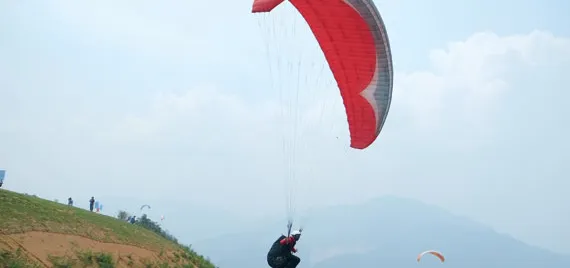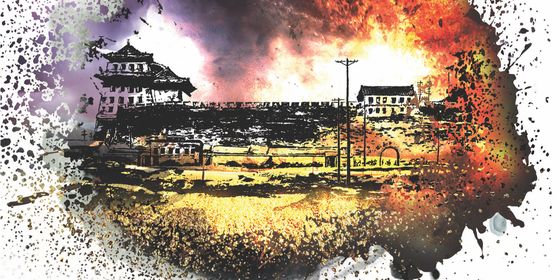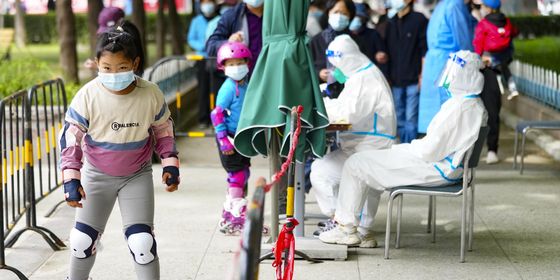Flying the friendly skies of the capital
Zhao Meiyuan is silent. His tanned, weathered face points upwards to the sky, brows knit in concentration. He is concerned with one thing: wind speed on the outskirts of Beijing in Chaobaihe (潮白河), one and a half hour drive outside the Fourth Ring Road. No more than six meters per second is the rule, so today is a go.
Zhao Meiyuan, or Dollar Zhao as he is known in English, is the founder and chief coach at Super-Wing Paragliding Club (大羽滑翔伞俱乐部 Dàyǔ Huáxiáng Jùlèbù) in Beijing. For each day of flying, he or his coaches go through the checklist of safety measures to ensure that paragliders, or pilots, are not exposed to more risk than one would expect hundreds of meters above the ground attached to a parachute.
Wind speed, check. Temperature, not more than a 12 degrees Celsius difference in a single day, check. Equipment, check.
When the coaches give the go-ahead, everyone heads for Chaobaihe.

Dollar Zhao testing the speed and direction of the wind so he can get his students in the air
Once there, Hebe Hua waits for her turn to practice raising the parachute vertically under Zhao’s tutelage. She wears a floppy, black fisherman’s hat and army fatigues that are a couple of sizes too large, but she has a big smile on her face. In her mid-twenties, the advertising agency employee is the characteristically overstressed, young urban worker.
“Normal life is too boring and work pressure is very heavy,” says Hua with a sigh. “That’s why we like these extreme sports, it excites us, and makes life more fun,” she says, brightening up. “I’m really looking forward to the next course.”
Flying or dreams of flying do not just appeal to the stereotypically athletic, young adrenaline junkies. In China, pilots come from far-flung corners o f the demographic chart—from yuppie CEOs to 60-year-old grandparents. Though, interestingly, Zhao thinks that this willbe the sport of choice for women in the future. He believes that this is because of the social pressure young Chinese men face to save money in order to support their families or future families.
“If the girls have some money, it is easy for them to spend this on travel or learning a new skill like paragliding,” he says. “The boys may have to face the pressure of buying a house, mortgage pressure, etc.”
And you certainly need money for this type of hobby.
Zhao’s beginner course costs 8,000 RMB and purchasing your own equipment will set you back about 26,000 RMB. Because there are no paragliding certification requirements or licenses, it is absolutely essential that new pilots train with professionals before attempting to fly.
Liao Yu is a prime example of such spending power. The early-thirties consultant started taking paragliding lessons in 2011 and travels around the world with her equipment, seeking her next adventure. “I take it with me so I can paraglide when I travel. I bought portable equipment that only weighs 14 kilograms, so it’s easy to carry,” she says, clearly proud of her set.
“I spent this weekend in Linzhou, Henan Province, which is a good place for paragliding, but, for the past year and a half, I’ve flown not only in China, but also in Turkey, France and Spain.”
Not everyone has had such an easy time getting off the ground. For many, flying is just a dream. This was true o f 63 year-old Chen Tieguang who chased his dream for decades until his first flight on his 50th birthday.
Chen’s parents were founding members of the Chinese Air Force, so, as a little boy, Chen grew up dreaming of taking to the sky.
Despite the unstable economic environment in China in the 60s and 70s, Chen was also able to enter the Chinese Air Force.

Hebe Hua at her third training session, looking forward to finally taking to the sky
“I entered into the Air Force but not as a pilot. I was an engineer on the ground, servicing bombers for nearly 17 years,” he says. Fate put him torturously close to reaching his dreams but unable to fulfil them. “I wanted to fly, but there was no chance. And after I left the Air Force, I was too busy with a new job.”
After five decades o f waiting, he finally got his chance. “My first flight was in 1999, in Mang Mountain, in the Beijing Ming Tombs Scenic Area, Changping District, where many people used to practice in the late 1990s. Then, the sky was already filled with parachutes,” he remembers fondly.
“That day, in the morning, I trained on the ground for two hours in the afternoon. Then, I tried the small-hill flight, and I fi-nally flew into the sky. The next day, I flew up to 530 meters. From then on, I never tired of flying,” he said excitedly.
But paragliding, like other extreme sports, is not without its risks. Pilots have to maneuver their parachutes using lines, harnesses and brakes, as well as use thermal air currents to launch themselves higher and lower.
Essentials also include reserve parachutes, carabiners, helmets, speed systems, radios and GPS systems.
Additionally, pilots must wear warm, comfortable and wind-resistant clothing along with sunscreen and lip balm to protect them from the elements.
And what about accidents? Technology, Zhao says, can reduce the chances of accidents, but there is still risk involved.
“For all the risk factors, we can only really control about 70 percent of it,” he says. “Thirty percent of the risks are not controllable, and you can not predict unforeseen circumstances.”
That, however, shouldn’t stop anyone from trying paragliding. It certainly didn’t stop 63-year-old Chen. He has had a few close calls himself. His first accident hit on January 28, 2000, and he remembers it vividly. In Maoming, located in the Guangdong Province, he injured his waist badly trying to maneuver around a series of cliffs. But after the accident, Chen was up and flying again in three months.
His more serious accident occurred in October 2009 in Beijing’s Mang Mountain. “I just took off and was not too high, still rising, when I noticed there was something wrong with the parachute,” he recalled. “I thought that it would be okay, that—if I continued to adjust it—the parachute would return to its normal state, so I didn’t use the reserve parachute to escape. But soon, the parachute descended quickly, slamming me into a large pine tree. My right elbow rammed into something hard and it dangled limply. At that point, I thought my elbow was
dislocated. I was upside down in a tree, about two to three meters from the ground when I fainted.” He stops to take a breath. “When I woke up, I was in the hospital. My friends had taken me there. The diagnosis was that the bones in my right elbow were smashed into tiny pieces.”
After surgery and a few months of rest, Chen was out in his parachute again. He took four months to recover and was 59 years old when the accident occurred.

After three training courses, these students are mastering the art guiding their chutes on the ground
Chen, apparently, is in good company with this passion. Today, there are a few thousand para-practitioners in the country, and Beijing is where you can find the most, a few hundred according to Zhao’s estimates.
However, factors specific to Beijing threaten the city’s rank as the top spot in the sport’s future.
“It is affected by political factors, such the government’s two big meetings, the National People’s Congress (NPC) and the Chinese People’s Political Consultative Conference (CPPCC) held
every March. During the two meetings, there is a flight ban, so basically flying is prohibited in March,” Zhao says.
Also, China, in general, takes a tough stance on unauthorized flying all together, and pilots caught flying without an official permit may face criminal detention. In September 2011, 39 commercial flights were disrupted in Shanghai’s two airports by paragliders carrying nine people. A day before the Shanghai incidents, a powered parachute was reported to have intruded into the airspace of Jiangsu Province’s Nantong Xingdong Airport, forcing a flight to be diverted to Shanghai.
Apart from that, the city’s weather also leaves a lot to be desired. “The winter lasts three to four months,” Zhao explains. “It’s very cold and inconvenient for flying.” Average temperatures from December to February are well below zero degrees Celsius and can dip to as low as -20 degrees on the ground, and it’s much colder zipping through the air, 600 meters off the ground.
Other regions in China have the upper hand with less political constraints and cooperative weather conditions, such as Sichuan Province or Zhejiang Province. Their winters are shorter and flying can be enjoyed throughout the year.
But, the weather is no bar for Beijing’s paragliding-addicts. “If you can endure the chilly weather, you can fly. But it means that you really have an addiction (flying),” Zhao said laughing, but he stopped to smile with pride. “Sometimes I fly in the winter.”
“The development of the aviation industry always progressed with the death of pioneers who tested the performance of new parachutes,” Zhao says. “If the average person only notices one-side—the danger, the accidents—I do not know how to persuade them to change their ideas.”
Chen wholeheartedly agrees. “My two accidents won’t stop me from flying, but I will be more careful in the future.” For him, and others who love to take to the sky, it’s much
more than a hobby. “Sometimes, when I fly in the sky and i f the weather is very fresh and clean, I feel I’m swimming in a deep ocean. It’s deeply emotionally and mentally relaxing.”
By Nicole Sy and Alicia Zhang
Photographs by Chen Shixing (陈时幸)












